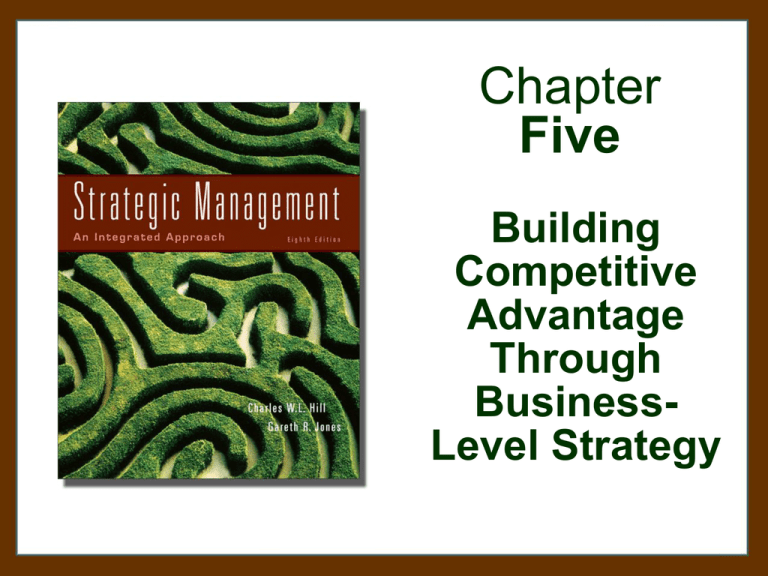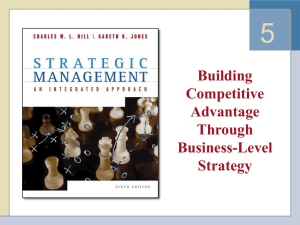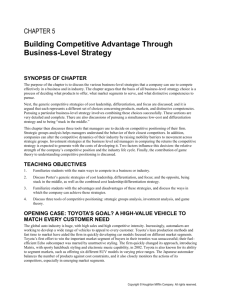
Chapter
Five
Building
Competitive
Advantage
Through
BusinessLevel Strategy
The Nature of Competitive
Positioning (Cont’d)
The process of defining a business involves
decisions about
• (1) customer needs, or what is to be satisfied;
• (2) customer groups, or who is to be satisfied;
and
• (3) distinctive competences, or how customer
needs are to be satisfied.
These three decisions are the basis of the
choice of a business-level strategy because
they determine how a company will
compete in an industry
Copyright © Houghton Mifflin Company. All rights reserved.
5|2
The Nature of Competitive
Positioning
In order to maximize its competitive
advantage, a company must find the best
way to position itself against its rivals. It
does this by using business-level strategy.
Business-level strategy is the plan of
action that strategic managers adopt to use
a company’s resources and distinctive
competences to gain a competitive
advantage over its rivals in a market or
industry
Copyright © Houghton Mifflin Company. All rights reserved.
5|3
Customer needs and product
differentiation
Customer needs are desires, wants, or
cravings that can be satisfied by means of
the characteristics of a product or service.
For example, a person’s craving for
something sweet can be satisfied by a
carton of Ben & Jerry’s ice cream, a
Snickers bar, or a spoonful of sugar.
Product differentiation is the process of
creating a competitive advantage by
designing products—goods or services—to
satisfy customer needs.
Copyright © Houghton Mifflin Company. All rights reserved.
5|4
Customer needs and product
differentiation (Cont’d)
All companies must differentiate their
products to a certain degree in order to
attract customers and satisfy some minimal
level of need.
However, some companies differentiate
their products to a much greater degree
than others, and this difference can give
them a competitive edge.
Copyright © Houghton Mifflin Company. All rights reserved.
5|5
Customer Groups and Market
Segmentation
Market Segmentation
The way customers can be grouped based on
important differences in their needs or preferences
Main Approaches to Segmenting Markets
1. Ignore differences in customer segments –
Make a product for the typical or average customer
2. Recognize differences between customer groups –
Make products that meet the needs
of all or most customer groups
3. Target specific segments –
Choose to focus on and serve just
one or two selected segments
Copyright © Houghton Mifflin Company. All rights reserved.
5|6
Identifying Customer Groups
and Market Segments
Figure 5.1
Copyright © Houghton Mifflin Company. All rights reserved.
5|7
Distinctive Competencies
The third issue in business-level strategy is to decide
which distinctive competences to pursue to satisfy
customers’ needs and customer groups.
Four ways in which companies can obtain a competitive
advantage: superior efficiency, quality, innovation, and
responsiveness to customers.
• The Four Seasons hotel chain, for example, attempts to do all it
can to provide its customers with the highest quality
accommodations and the best customer service possible.
In making business strategy choices, a company must
decide how to organize and combine its distinctive
competences to gain a competitive advantage.
Copyright © Houghton Mifflin Company. All rights reserved.
5|8
Implementing the Business Model
To develop a successful business model,
strategic managers must devise a set of
strategies that determine:
•
•
•
•
How to DIFFERENTIATE their product
How to PRICE their product
How to SEGMENT their markets
How WIDE A RANGE of products to develop
A profitable business model depends on
providing the customer with the most value
while keeping cost structures viable.
Copyright © Houghton Mifflin Company. All rights reserved.
5|9
Wal-Mart’s Business Model
Figure 5.3
Copyright © Houghton Mifflin Company. All rights reserved.
5 | 10
Competitive Positioning
at the Business Level
Maximizing the profitability of the company’s business Figure 5.4
model is about making the right choices with regard to
value creation through differentiation, costs, and pricing.
Source: Copyright © C. W. L. Hill & G. R. Jones,
“The Dynamics of Business-Level Strategy,”
(unpublished manuscript, 2002).
Copyright © Houghton Mifflin Company. All rights reserved.
5 | 11
Generic Business-Level Strategies
1. Cost Leadership
Lowest cost structure vis-à-vis competitors
allowing price flexibility & higher profitability
2. Focused Cost Leadership
Cost leadership in selected market niches where
it has a local or unique cost advantage
3. Differentiation
Features important to customers & distinct from
competitors that allow premium pricing
4. Focused Differentiation
Distinctiveness in selected market niches where
it better meets the needs of customers than the
broad differentiators
Copyright © Houghton Mifflin Company. All rights reserved.
5 | 12
Cost Leadership
Cost leaders establish a cost structure that
allows them to provide goods and services
at lower unit costs than competitors.
Strategic Choices
• The cost leader does not try to be the
industry innovator.
• The cost leader positions its products to
appeal to the “average” or typical customer.
• The overriding goal of the cost leader is to
increase efficiency and lower its costs
relative to industry rivals.
Copyright © Houghton Mifflin Company. All rights reserved.
5 | 13
Advantages of
Cost Leadership Strategies
Protected from industry competitors by
cost advantage
Less affected by increased prices of
inputs if there are powerful suppliers
Less affected by a fall in price of
inputs if there are powerful buyers
Purchases in large quantities increase
bargaining power over suppliers
Ability to reduce price to compete
with substitute products
Low costs and prices are a barrier to entry
Cost leaders are able to charge a lower price
or are able to achieve superior profitability
than their competitors at the same price.
Copyright © Houghton Mifflin Company. All rights reserved.
5 | 14
Disadvantages of
Cost Leadership Strategies
Competitors may lower
their cost structures.
Competitors may
imitate the cost
leader’s methods.
Cost reductions may
affect demand.
Copyright © Houghton Mifflin Company. All rights reserved.
5 | 15
Differentiation
Companies with a differentiation strategy
create a product that is different or distinct
from its competitors in an important way.
Strategic Choices
• A differentiator:
» Strives to differentiate itself on as many
dimensions as possible.
» Focuses on quality, innovation, and
responsiveness to customer needs.
» May segment the market in many niches.
» Concentrates on the organizational functions that
provide a source of distinct advantages.
Copyright © Houghton Mifflin Company. All rights reserved.
5 | 16
Advantages of
Differentiation Strategies
Customers develop brand loyalty.
Powerful suppliers are not a problem because the
company is geared more toward the price it can
charge than its costs.
Differentiators can pass price increases on to
customers.
Powerful buyers are not a problem because the
product is distinct.
Differentiation and brand loyalty are barriers to entry.
The threat of substitute products depends on
competitors’ ability to meet customer needs.
Differentiators can create demand for their
distinct products and charge a premium price,
resulting in greater revenue and higher profitability.
Copyright © Houghton Mifflin Company. All rights reserved.
5 | 17
Disadvantages of
Differentiation Strategies
Difficulty maintaining long-term
distinctiveness in customers’ eyes.
•
•
Agile competitors can quickly imitate.
Patents and first-mover advantage are
limited in their duration.
Difficulty maintaining premium price.
Copyright © Houghton Mifflin Company. All rights reserved.
5 | 18
Focus
The focuser strives to serve the need of a
targeted niche market segment where it has
either a low-cost or differentiated competitive
advantage.
Strategic Choices
• The focuser selects a specific market niche
that may be based on:
Geography
Type of customer
Segment of product line
• Focused company positions itself as either:
Low-Cost or
Differentiator
Copyright © Houghton Mifflin Company. All rights reserved.
5 | 19
Advantages of
Focus Strategies
The focuser is protected from rivals to the
extent it can provide a product or service
they cannot.
The focuser has power over buyers because
they cannot get the same thing from anyone
else.
The threat of new entrants is limited by
customer loyalty to the focuser.
Customer loyalty lessens the threat from
substitutes.
The focuser stays close to its customers and
their changing needs.
Copyright © Houghton Mifflin Company. All rights reserved.
5 | 20
Disadvantages of
Focus Strategies
The focuser is at a disadvantage with regard
to powerful suppliers because it buys in
small volume (but it may be able to pass
costs along to loyal customers).
Because of low volume, a focuser may have
higher costs than a low-cost company.
The focuser’s niche may disappear because
of technological change or changes in
customers’ tastes.
Differentiators will compete for a focuser’s
niche.
Copyright © Houghton Mifflin Company. All rights reserved.
5 | 21












